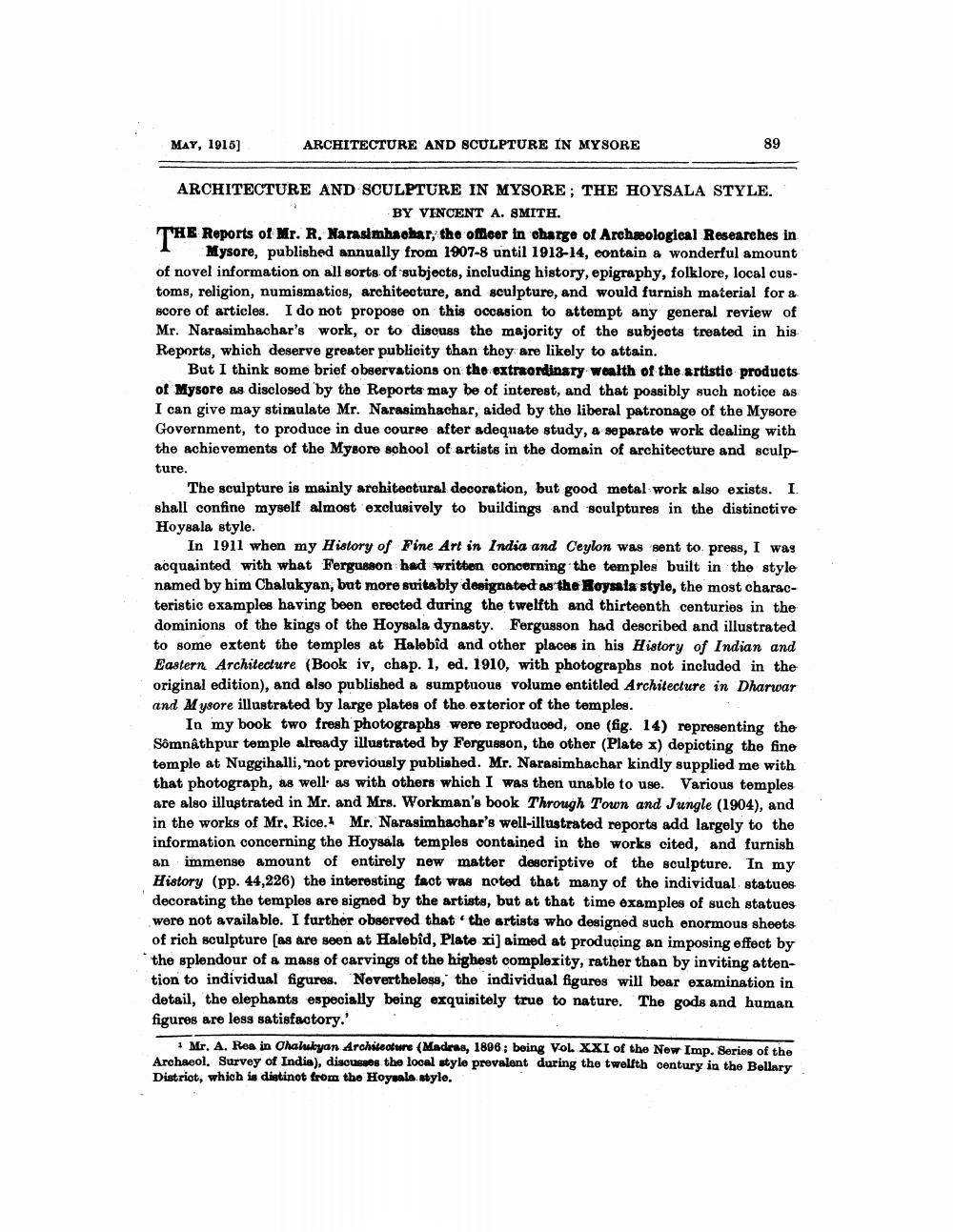________________
MAY, 1915)
ARCHITECTURE AND SCULPTURE IN MYSORE
89
ARCHITECTURE AND SCULPTURE IN MYSORE; THE HOYSALA STYLE.
BY VINCENT A. SMITH. THE Reports of Mr. R. Narasimhaohar, the officer in charge of Archæological Researches in
Mysore, published annually from 1907-8 until 1913-14, contain a wonderful amount of novel information on all sorts of subjects, including history, epigraphy, folklore, local customs, religion, numismatics, architecture, and sculpture, and would furnish material for & score of articles. I do not propose on this occasion to attempt any general review of Mr. Narasimhachar's work, or to discuss the majority of the subjects treated in his Reports, which deserve greater publicity than they are likely to attain.
But I think some brief observations on the extraordinary wealth of the artistic products of Mysore as disclosed by the Reports may be of interest, and that possibly such notice as I can give may stimulate Mr. Narasimhachar, aided by the liberal patronage of the Mysore Government, to produce in due course after adequate study, a separate work dealing with the achievements of the Mysore school of artists in the domain of architecture and sculpture.
The sculpture is mainly arohitectural decoration, but good metal work also exists. I. shall confine myself almost exclusively to buildings and soulptures in the distinctive Hoysala style.
In 1911 when my History of Fine Art in India and Ceylon was sent to press, I wag acquainted with what Fergusson had written concerning the temples built in the style named by him Chalukyan, but more suitably designated as the Hoysala style, the most characteristic examples having been erected during the twelfth and thirteenth centurios in the dominions of the kings of the Hoysala dynasty. Fergusson had described and illustrated to some extent the temples at Halebid and other places in his History of Indian and Eastern Architecture (Book iv, chap. 1, ed. 1910, with photographs not included in the original edition), and also published a sumptuous volume entitled Architecture in Dharwar and Mysore illustrated by large plates of the exterior of the temples.
In my book two fresh photographs were reproduced, one (fig. 14) representing the Somnathpur temple already illustrated by Fergusson, the other (Plate x) depicting the fine temple at Nuggihalli, not previously published. Mr. Narasimhachar kindly supplied me with that photograph, as well as with others which I was then unable to use. Various temples are also illustrated in Mr. and Mrs. Workman's book Through Town and Jungle (1904), and in the works of Mr. Rice. Mr. Narasimhachar's well-illustrated reports add largely to the information concerning the Hoysala temples contained in the works cited, and furnish an immense amount of entirely new matter descriptive of the sculpture. In my History (pp. 44,226) the interesting fact was noted that many of the individual statues decorating the temples are signed by the artists, but at that time examples of such statues were not available. I further observed that the artists who designed such enormous sheets of rich sculpture (as are seen at Halebîd, Plate xi) aimed at producing an imposing effect by the splendour of a mass of carvings of the highest complexity, rather than by inviting attention to individual figures. Novertheless, the individual figures will bear examination in detail, the elephants especially being exquisitely true to nature. The gods and human figures are less satisfactory.'
Mr. A. Roa in Ohalukyan Architecture (Madras, 1806; being VOL XXI of the New Imp. Series of the Archaeol, Survey of India), discusses the local style prevalent during the twelfth century in the Bellary District, which is distinot from the Hoynala style.




